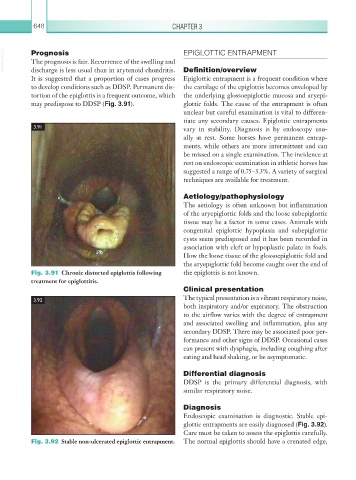Page 673 - Equine Clinical Medicine, Surgery and Reproduction, 2nd Edition
P. 673
648 CHAPTER 3
VetBooks.ir Prognosis EPIGLOTTIC ENTRAPMENT
The prognosis is fair. Recurrence of the swelling and
discharge is less usual than in arytenoid chondritis. Definition/overview
It is suggested that a proportion of cases progress Epiglottic entrapment is a frequent condition where
to develop conditions such as DDSP. Permanent dis- the cartilage of the epiglottis becomes enveloped by
tortion of the epiglottis is a frequent outcome, which the underlying glossoepiglottic mucosa and aryepi-
may predispose to DDSP (Fig. 3.91). glottic folds. The cause of the entrapment is often
unclear but careful examination is vital to differen-
tiate any secondary causes. Epiglottic entrapments
3.91 vary in stability. Diagnosis is by endoscopy usu-
ally at rest. Some horses have permanent entrap-
ments, while others are more intermittent and can
be missed on a single examination. The incidence at
rest on endoscopic examination in athletic horses has
suggested a range of 0.75–3.3%. A variety of surgical
techniques are available for treatment.
Aetiology/pathophysiology
The aetiology is often unknown but inflammation
of the aryepiglottic folds and the loose subepiglottic
tissue may be a factor in some cases. Animals with
congenital epiglottic hypoplasia and subepiglottic
cysts seem predisposed and it has been recorded in
association with cleft or hypoplastic palate in foals.
How the loose tissue of the glossoepiglottic fold and
the aryepiglottic fold become caught over the end of
Fig. 3.91 Chronic distorted epiglottis following the epiglottis is not known.
treatment for epiglottitis.
Clinical presentation
The typical presentation is a vibrant respiratory noise,
3.92
both inspiratory and/or expiratory. The obstruction
to the airflow varies with the degree of entrapment
and associated swelling and inflammation, plus any
secondary DDSP. There may be associated poor per-
formance and other signs of DDSP. Occasional cases
can present with dysphagia, including coughing after
eating and head shaking, or be asymptomatic.
Differential diagnosis
DDSP is the primary differential diagnosis, with
similar respiratory noise.
Diagnosis
Endoscopic examination is diagnostic. Stable epi-
glottic entrapments are easily diagnosed (Fig. 3.92).
Care must be taken to assess the epiglottis carefully.
Fig. 3.92 Stable non-ulcerated epiglottic entrapment. The normal epiglottis should have a crenated edge,

